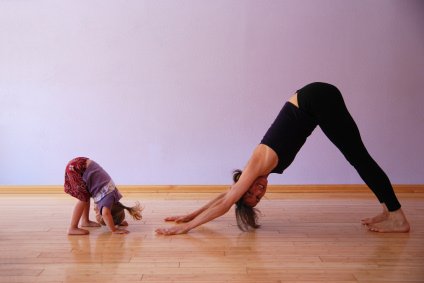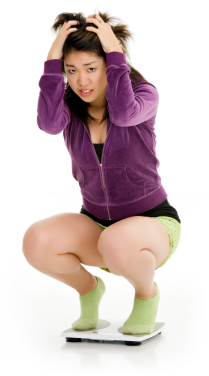Easy, at-home ways of using yoga to alleviate tension in the younger set
by Charlotte Bradley, YogaFlavoredLife.com
It may look like child’s play, but growing up in today’s world can be a major challenge. What with global warming, terrorism, and the political climate, not to mention daily problems like family strife or trouble at school, it’s no wonder that today’s kids are stressed out.
As parents, we struggle to ensure our children’s health and happiness. Knowing how to respond when your son or daughter is exhibiting signs of stress can be daunting. But there is a simple way to help our kids take on life’s challenges while getting physically and emotionally stronger – the ancient practice of yoga.
You probably have heard of yoga, or maybe you’re a practicing yogi yourself. However, many of us are unaware of exactly how or why yoga has such a tremendous effect on our bodies and minds. In her book Yoga for the Special Child, author Sonia Sumar defines yoga as “a scientific system of physical and mental practices that originated in India more than three thousand years ago. Its purpose is to help each one of us achieve our highest potential and to experience enduring health and happiness.”
It stands to reason that the younger a person embarks on a yoga practice, the better. Studios across the country are realizing this and offering classes for babies, young children, and teenagers. Still, with the myriad of extra-curricular programs so many kids are involved in, can yoga really offer anything new?
The many benefits of yoga for children
Yoga teaches physical skills like flexibility, strength, stamina, balance and coordination, but the same could be said about gymnastics, dance, or any number of team sports. But unlike these other physical activities, yoga is non-competitive, focusing on one’s own progress and abilities. As wonderful as competitive sports can be, sometimes the pressure to perform can bring even more stress into a child’s life. Some might argue that team sports foster self-discipline and confidence, but yoga also does this in spades. And a good yoga practice promotes creativity, self-expression, and compassion to boot.
If you’re concerned about your child’s physical fitness and health (and who isn’t, now that childhood obesity is such a omnipresent problem in our country), consider this: sports-related injuries are growing ever more common in young kids, setting them up for a lifetime of chronic pain and mobility problems. Yoga teaches proper body alignment, helping kids use their bodies more safely – so it’s a great compliment to any additional athletic pursuits.
Kid-friendly yoga: what to look for
As great as yoga can be for children, it’s probably not the best idea to throw a third-grader into an adult Bikram (hot yoga) class. Kids need a practice that suits their physical and emotional needs. Luckily, many studios across the nation are responding to the growing interest in yoga for the younger set. It’s easier than ever to find classes specifically designed for babies, young children, or teens. Try doing an Internet search for local yoga studios and see what is available in your area. Even if you can’t find an appropriate class, you can incorporate some basic yoga techniques into your child’s life by practicing with her at home.
Fun poses to try with your kids
You don’t need to be an experienced yogi to help your family reap the benefits of yoga. Try the following three exercises with your children – all you need is a small space to spread out, a willing mind, and an open heart. These exercises are based on the knowledge that youngsters love to imagine themselves as different objects or animals, so feel free to make noises, incorporate music, or even make up stories to go along with the poses:
1. Tree pose with a partner (teaches balance, support for others, and cooperation): Stand hip-to-hip next to your partner (this is a great one for siblings to do together, or parent and child), both of you facing outward. Imagine yourself as a strong tree in the forest. The roots of the tree are your feet, so start by standing very tall, with your feet together. Place your arms around each other’s backs, and focus on an unmoving point on the wall (this will help your balance). Next, lift one foot off the ground, transferring your weight to the other standing leg. Once you find your balance, press the lifted foot into the standing leg at the calf or thigh, keeping the knee of the lifted leg pointing outward. Help each other stay balanced by keeping your arms around each other’s backs, and lift your other free hands up to join together over your heads. As you try and keep yourselves steady, imagine that the wobbliness you feel is just the wind gently shaking the branches of your tree. Lean into each other while staying strong and erect. You’ll find strength in yourself, and in your partner.
2. Downward Facing Dog (strengthens arms and legs, stretches back): Ever seen a dog stretch out in the morning? This pose will help you feel just like your favorite mutt. First, get down on all fours like a puppy, with your knees hip width apart and your hands shoulder-width apart, fingers spread out and pressing into the floor. Take a deep breath in, and arch your back, curling your toes under. Exhale and straighten your legs, pushing the floor away from your hands. Your body should look like an inverted V. Feel free to bark or growl like a dog while you hold the pose, keeping arms and legs straight.
3. Savasana – “Corpse Pose” (perfect for relaxation and calming the mind). Lie on your back, letting your feet to fall out to the side. Your arms can rest at your sides as well, with palms facing up, and a little space between the arms and the body. Now, starting at the tippy tops of your toes, focus on relaxing each part of your body – allow yourself to feel heavy, like you are sinking into the ground, becoming part of the earth. Keep relaxing each body part all the way up to your face; let your jaw relax, your eyes relax, even your nose. Breathe deeply and let all the bad stuff that happened in your day just drift away. Stay like this for as long as you want, and the gently bring yourself out of it by wiggling your fingers and toes, slowly waking up your limbs.
These are just a few fun, quick ways to bring yoga into your young one’s life. Hopefully you will spark interest for the practice in your child, opening him or her up to a lifetime of good health, sound mind, and strong body.
—
Charlotte Bradley is a guest writer here at More4kids. She is the publisher of YogaFlavoredLife.com and an avid yoga practitioner. She was a student of karate for many years and took up yoga only tentatively after the birth of her sons and a knee injury left her looking for a less high-impact form of exercise. It was love at first pose as Charlotte saw how quickly yoga sped her rehabilitation along. She also found that yogic relaxation techniques lent her proper focus, bringing balance into her life as well as a greater appreciation for how blessed she truly is. She lives in Ottawa, Ontario with her husband and twin boys, Charlie and Patty, who keep her on her feet and on the go. Her golden retriever supervises Charlotte’s yoga practice from a spare mat, with his eyes closed. Visit YogaFlavoredLife.com for a free yoga report to help you choose a class that fits your needs.











Add Comment